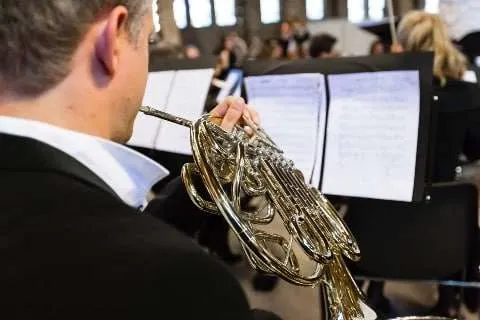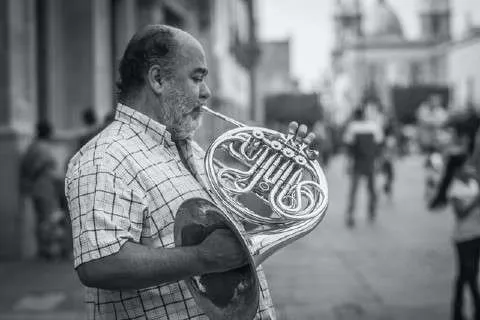The left handed French horn has a unique design among all brass instruments. While most instruments are played using the right hand, the French Horn is played with the left. The left hand is used to adjust the valves, allowing for a higher or lower pitch, while the right hand is focused on producing the stop notes in the bell of the instrument.
Valves are placed for the left hand because before the invention of valves for brass instruments, many of the notes could not be played. The left-handed design of the French Horn now allowed a greater versatility in playing notes.
We will now look at the French Horn in more detail.
Table of Contents
Why is the French Horn Left Handed?
It is said that the design of the modern French horn was influenced by a story from a time when hunting horns were used. Back then, there were frequent accidents by huntsmen who weren’t particularly known for their accuracy and, hence, were often involved in “friendly fire.”
Lord Corno the Wild was never impressed by his hornsmen. He was even rumored to disregard any accidents from huntsmen that proved fatal for the hornsmen. Since the hornsmen realized they would receive no protection from Lord Corno, they requested Boosey & Hawkes to design their horns in such a way that their hearts would be protected.
This then led to the creation of left-handed horns in which the tubing protects the heart because, in right-handed horns, the left side of the chest was exposed. With the invention of the left-handed horn, the fatality and injury rate of hornsmen dropped considerably. This is how the design of the left-handed French Horns came to be.

While the story mentioned above may or may not be true, there is a thought and a musical purpose behind the design of the French Horn. In the past, most brass instruments were used to play notes in open harmonics. Because of this, it limited their ability to play all the notes on the scale. Even the chromatic notes weren’t being played before the early 19th century.
To counter this issue, people came up with several alternatives to play the other notes. With bugles, people made them with keys, quite similar to a saxophone. For trumpets and cornets, they had tiny holes on them that the musician could cover or open with their fingers as needed.
When it came to using the French Horn, the pitch could be manipulated using the right hand in the bell. It could either be lowered by a tone or a whole step, depending on the need. It could also be raised by a semitone or a half step when the holes were fully covered by the fingers.
The whole mechanism of the French Horn was originally for the right hand, as everything relied on using your fingers and the positioning of your hand. However, all this was before the invention of valves in horns. When valves were finally introduced, there was no change in the design of the horn. Players simply employed the hand-stopping technique to produce notes outside of its normal harmonic series and used their left hand to control the valves to change the key.
The valves and, consequently, the left hand have become a vital component of playing the French Horn. The right hand Is still used to change the sound and pitch, but this doesn’t require too much attention.
How Do You Hold a French Horn?
To hold a French Horn, one needs to be mindful of a few things. The person must sit in an upright position with their left leg ahead of the right one. They should sit upright to face the conductor and not recline on their back bend forward and down to reach the mouthpiece. This is to ensure there is a balance between relaxation and alertness. In this way, the mouthpiece of the French Horn is raised a little to adjust with the head’s position, but not too much.
For the instrument itself, the person should hold the French Horn by keeping the bell away from the torso and facing backward. This allows the sound to pass through without any interference. Before you start, place the horn on your right thigh to make sure the bell is positioned properly.
Holding the French Horn is a matter of positioning your hands and fingers. The person’s fingertips of the left hand need to be placed on each key at an even distance. This will help them adjust the valve levers and use the horn skillfully. The index finger is placed on valve 1, the middle on valve 2, and the ring finger or valve 3. The thumb hooks around to the other side to press the rotary valves.
There’s a pinky hook or key for your left little finger to rest in, which helps keep your hand stable while you move your fingers on the valves. It is possible that the location of the pinky hook is not entirely suitable for the finger. If that’s the case, the position can be readjusted accordingly by a Brassiere to suit the exact size and shape of the left hand.
The right hand is only positioned inside the bell. You make a ‘C’ shape with your fingers and thumb and partially insert your hand into the opening of the bell so that the weight of the bell rests on just the thumb and the knuckles of the other fingers.
Why Do French Horn Players Put Their Hand in the Bell?

Since traditional design wouldn’t allow for all the notes to be played, a technique called hand stopping was invented to solve this issue. Whenever horn players closed the bell either fully or partially, they would also vary the pitch. This would enable them to produce diatonic scales on a wider range.
Since the invention of valves, modern French Horns are now built with a slightly sharper tone. Horn players can correct the pitch when their right hand is in the bell.
Is There a Right Handed French Horn?
It is likely that you may be able to get a right-handed French Horn custom-made. However, it would be extremely rare to find one. Right-handed French horns would be a lot more expensive too, as the French Horn is characteristically designed to be left-handed.
Even if you could get a right-handed one made, definitely do not do it. It’s better to get used to playing with your left hand if you ever want to play in an orchestra. Just like several other instruments played in a group, like a flute, violin, or cello, you wouldn’t want to accidentally hit your neighbor because you’re moving your arms or instrument in the wrong direction.
Do Left Handed People Make Better French Horn Players?
The assumption that left-handed people can play the French Horn better is unfounded. Although beginners may find it easier to play the instrument if they are left-handed, with practice, even right-handed people should be able to play the French Horn just as well.
Ultimately, it is not a matter of what the dominant hand is; rather, it all boils down to your ability to match the pitch, how skillfully you use your hands, and how nimble your fingers are. Right-handed people using the French Horn can grow to become ambidextrous, hence giving them a wider range of skills.

As someone without a left hand who was also keen to play the French horn, I got one adapted by a trombone designer/maker in the U.K., Michael Ralf. The horn is an old Paxman Studenti compensating horn. I’ll never be that good and certainly won’t be able to do hand stopping (my stump stopping is not 😊) I get pleasure from the noise I make.
That’s very impressive that you didn’t let it deter you from playing the horn! I’m sure that you bring lots of pleasure to those around you :-)